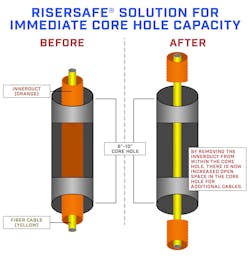As part of its RiserSafe program, Concert Technologies recently produced a document describing a solution to a widespread problem: the lack of pathway space in a building riser. In the document titled “Building Infrastructure Challenges—Innerduct,” Concert explains the conundrum that arises when building occupants require the use of innerduct when deploying fiber-optic cable in a riser. “While the use of innerduct was at one time strongly encouraged due to the historically fragile nature of fiber-optic cabling, such is no longer the case,” the document says. “Fiber-optic cabling is far more resilient today than it was when it was first being deployed,” Concert continues. “Its bend radius is more forgiving, its jacketing is more protective, and even unarmored, jacketed fiber can now be considered safe from harm when deployed in an infrastructure that is actively monitored and managed.”
The company further points out that no ICT standard requires the installation of innerduct along with fiber-optic cabling. Importantly, in an environment such as a multi-tenant commercial building, “Carriers often will come in with their own requirement that their fiber travels alone through its own innerduct, and no other cabling is permitted to share the same space,” Concert emphasizes. This practice results in a single fiber-optic cable, housed within innerduct, occupying a significant portion of a 4-inch riser conduit.
Concerning the aforementioned carrier requirements, Concert states, “It is important to understand that the carrier is bound to abide by your site’s requirements. If your property were to dictate ‘No innerduct shall be used,’ [or some alternative language] to save core holes, conduits, and other restrictive pathway spaces, that property requirement would override the desires of the carrier.”
The guidance provided here is part of a white paper from Concert Technologies titled “Impact of IoT Infrastructure for Commercial Real Estate Multi-Tenant Properties.” You can visit RiserSafe's resource library here.
About the Author
Patrick McLaughlin
Chief Editor
Patrick McLaughlin, chief editor of Cabling Installation & Maintenance, has covered the cabling industry for more than 20 years. He has authored hundreds of articles on technical and business topics related to the specification, design, installation, and management of information communications technology systems. McLaughlin has presented at live in-person and online events, and he has spearheaded cablinginstall.com's webcast seminar programs for 15 years.


